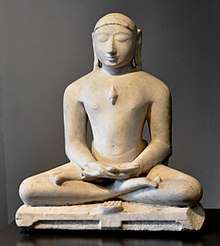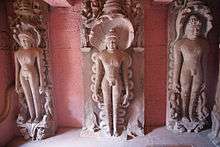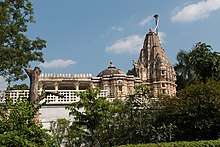Suparshvanatha
Suparśvanātha (Sanskrit: सुपार्श्वनाथ Suparśvanātha), also known as Suparśva, was the seventh Jain Tīrthankara of the present age (avasarpini). He was born to King Pratistha and Queen Prithvi at Varanasi on 12 Jestha Shukla in the Ikshvaku clan. He is said to have attained moksha at Śikharji on the sixth day of the dark half of the month of Phālguna.
| Suparshvanatha | |
|---|---|
7th Jain Tirthankara | |
 Idol of Suparśvanātha | |
| Venerated in | Jainism |
| Predecessor | Padmaprabha |
| Successor | Chandraprabha |
| Symbol | Swastika |
| Height | 200 bows (600 meters) |
| Age | 2,000,000 purva (141.12 Quintillion years) |
| Color | Golden |
| Personal information | |
| Born | |
| Died | |
| Parents |
|
| Part of a series on |
| Jainism |
|---|
 |
|
Jain prayers |
|
Ethics |
|
Major sects |
|
Texts |
|
Festivals
|
|
|
Jain biography
Life before renunciation
Suparśvanātha was the seventh Jain Tīrthankara of the present age (avasarpini).[1] He was born to King Pratistha and Queen Prithvi at Varanasi on 12 Jestha Shukla in the Ikshvaku clan.[2] There is temple dedicated to Suparshvanatha built in Bhadaini, Varanasi to commemorate the birth of Suparshvanatha.[3][4] Nine months before the birth of Suparśvanātha, Queen Prithivī dreamt the sixteen most auspicious dreams.[5] Suparśvanātha spent 5 lakh pūrva as youth (kumāra kāla) and ruled His kingdom for 14 lakh pūrva and 20 pūrvāṇga (rājya kāla).[6] Suparśvanātha was married and ruled after his father King Pratistha. He conducted affairs in state and looked after well being of individual.[7]
Renunciation
According to Jain legends, When he observed tree leaves falling and flower wilting, he renounced his worldly life. He gave his kingdom to his son and became a Jain ascetic. After 9 months and then obtained Kevala Jnana (omniscience). After a many years of spreading his knowledge, he is said to have attained nirvana at Sammed Shikharji on the sixth day of the dark half of the month of Phālguna.[7][6]
Disciples
According to Jain texts Balladatta Svami was the leader of the Suparśvanātha disciples and 20 lakh years he also achieved nirvana.[6]
As a historical figure
The Yajurveda is also said to have mentioned the name of Suparśvanātha but the meaning is different. It is an epithet of God which means "All-Pure Lord".
The Mahavagga book of the Khandhaka (1. 22. 13), a Buddhist text, mentions a temple of Suparśvanātha situated at Rajgir in the time of Gautama Buddha.[8]
At Mathura, there is an old stupa with the inscription of 157 CE. This inscription records that an image of the tīrthankara Aranatha was set up at the stupa built by the gods. However, Somadeva Suri stated in Yashstilaka and Jinaprabha Suri in Vividha Tirtha Kalpa that the stupa was erected for Suparśvanātha.[8]
Adoration
Svayambhūstotra by Acharya Samantabhadra is the adoration of twenty-four Tīrthankaras. Its five slokas (aphorisms) are dedicated to Tīrthankara Suparśvanātha.[9]
As an inanimate equipment (a vehicle, for example) requires an animate being (a man) for its operation, so does the body, that the soul adopts as its encasement, require the soul for its functioning. The body is repugnant, foul-smelling, perishable, and a source of anxiety and, therefore, it is futile to have attachment towards it. O Lord Suparśvanātha, this is your benign precept.
— Svayambhūstotra (7-2-32)[10]
Suparshvanatha is associated with Nandavarta (Dig.) & Svastika (Svet.) emblem, Sirisa tree, Varanandin (Dig.) & Matanga (Svet.) Yaksha and Kali (Dig.) & Santa (Svet.) Yakshi.[11][12]
In literature
Supasnath Chariyam was compiled during reign of Mokkhal in 1422-23 at Dilwara.[13]
Iconography
Suparshvanatha is usually depicted in a lotus or kayotsarga posture. Statues and paintings show his head shielded by a multi-headed serpent, fanned out like an umbrella.[14]
Serpent-hood iconography is not unique to Suparshvanatha; it is also found above the icons of Parshvanatha, the 23rd of the 24 tirthankaras, but with a small difference.[15] Suparshvanatha's serpent hood has five heads, and a seven (or more)-headed serpent is found in Parshvanatha icons. Statues of both tirthankaras with serpent hoods have been found in Uttar Pradesh and Tamil Nadu, dating to the 5th to 10th centuries.[16][17]
Unlike Parshvantha who is depicted with coils of snake behind the body, Suparshva is depicted with snake hood only overhead. Suparshva's emblem of swastika is carved (or stamped) beneath his legs as an icon identifier.[18][12][19]
- Suparsvanatha, c. 900 CE, Norton Simon Museum
- 16th century bronze idol of Suparsvanatha, Honolulu Museum of Art
- Jain chaumukha sculpture with Suparshvanath and three other Tirthankaras, 1st century
 Supārśva in middle with Pārśva on both side, Jain temple, Deogarh
Supārśva in middle with Pārśva on both side, Jain temple, Deogarh.jpg) Suparshvanatha with yaksha Varanandin and yakshi Kali
Suparshvanatha with yaksha Varanandin and yakshi Kali
Main temples
- Pavagadh Jain Temple
- Suparshavanath Basadi at Ranakpur
- Shri Mandavagadh Teerth, Mandu
- Suparshavanath Jain Basadi, Bhadaini
- Suparshavanath Jain Basadi, Narlai : believed to be more than 1000 years old.[20]
 Suparshavanath Temple at Ranakpur
Suparshavanath Temple at Ranakpur Suparshvanatha Basadi, Shravanabelagola
Suparshvanatha Basadi, Shravanabelagola
See also
| Wikimedia Commons has media related to Suparshvanatha. |
- God in Jainism
- Arihant (Jainism)
- Jainism and non-creationism
- Ikshvaku dynasty
References
Citations
- Tukol 1980, p. 31.
- Time of India & 4 Tirthankaras born in Varanasi.
- Singh 2009, p. 54.
- Lodha 2013, p. 544.
- Jain 2015, p. 188.
- Jain 2015, p. 189.
- Jain 2009, p. 78.
- Jain 2009, p. 77.
- Jain 2015, p. 44-50.
- Jain 2015, p. 45.
- Tandon 2002, p. 44.
- Titze 1998, p. 5.
- Neeraj & Nīraja 1991, p. 9.
- Cort 2010, p. 385.
- Cort 2010, pp. 278–279.
- Harvard & Tirthankara Suparsvanatha.
- Pal, Huyler & Cort 2016, p. 204.
- Harrell 2013, p. 124-125.
- Shah 1987, p. 139.
- Mehta 1970, p. 130.
Sources
- Johnson, Helen M. (1931), Suparshvanathacaritra (Book 3.5 of the Trishashti Shalaka Purusha Caritra), Baroda Oriental Institute
- Jain, Vijay K. (2015), Acarya Samantabhadra’s Svayambhustotra: Adoration of The Twenty-four Tirthankara, Vikalp Printers, ISBN 9788190363976,
Non-Copyright
- Tandon, Om Prakash (2002) [1968], Jaina Shrines in India (1 ed.), New Delhi: Publications Division, Ministry of Information and Broadcasting, Government of India, ISBN 81-230-1013-3
- Tukol, T. K. (1980), Compendium of Jainism, Dharwad: University of Karnataka
- Jain, Arun Kumar (2009), Faith & Philosophy of Jainism, Gyan Publishing House, ISBN 9788178357232, retrieved 23 September 2017
- Cort, John E. (2010), Framing the Jina: Narratives of Icons and Idols in Jain History, Oxford University Press, ISBN 978-0-19-538502-1
- Shah, Umakant Premanand (1987), Jaina-rūpa-maṇḍana: Jaina iconography, 1, Abhinav Publications, ISBN 978-81-7017-208-6
- Pal, Pratapaditya; Huyler, Stephen P.; Cort, John E. (2016), Puja and Piety: Hindu, Jain, and Buddhist Art from the Indian Subcontinent, University of California Press, ISBN 978-0-520-28847-8
- Harvard, "From the Harvard Art Museums' collections Tirthankara Suparsvanatha in Kayotsarga, or Standing Meditation, Posture and Protected by a Five-Headed Naga", www.harvardartmuseums.org
- Titze, Kurt (1998), Jainism: A Pictorial Guide to the Religion of Non-Violence, Motilal Banarsidass, ISBN 978-81-208-1534-6
- 4 Jain Tirthankaras born in Varanasi, The Times of India, 25 August 2015
- Neeraj, Jai Singh; Nīraja, Jayasiṃha (1991), Splendour of Rajasthani Painting, Abhinav Publications, ISBN 9788170172673
- Lodha, Jain Chanchalmal (2013), History of Oswals, Panchshil Publications, ISBN 9788192373027
- Singh, Rana (2009), Banaras: Making of India’s Heritage City, Cambridge Scholars Publishing, ISBN 9781443815796
- Mehta, Jodh Sinha (1970), Abu to Udaipur (Celestial Simla to City of Sunrise), Motilal Banarsidass
- Harrell, D. Fox (2013), Phantasmal Media: An Approach to Imagination, Computation, and Expression, MIT Press, ISBN 9780262019330